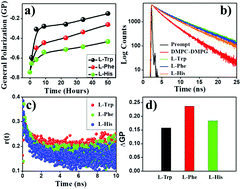Interaction of monomeric and self-assembled aromatic amino acids with model membranes: self-reproduction phenomena†
Abstract
The spontaneous formation of amyloid structures of proteins is responsible for several major human neurodegenerative diseases. Here, we demonstrate that the formation of amyloid aggregates of the amino acids results in the formation of supported phospholipid membrane and aggregated vesicles via fusion and self-reproduction of the lipid vesicles. Importantly, during the vesicle growth, we found the formation of large “mother vesicles” containing small “daughter vesicles”. This observation is significant for interpreting the protein–membrane interaction and mimicking the origin of cellular life.



 Please wait while we load your content...
Please wait while we load your content...